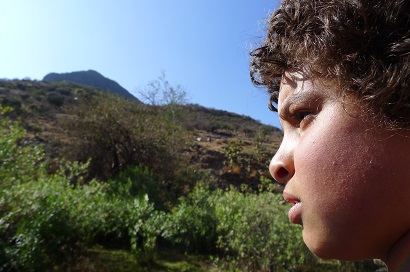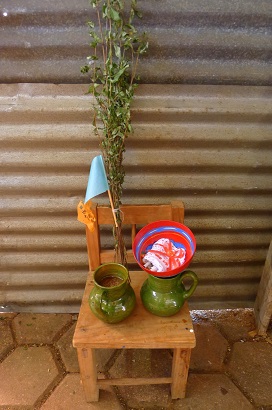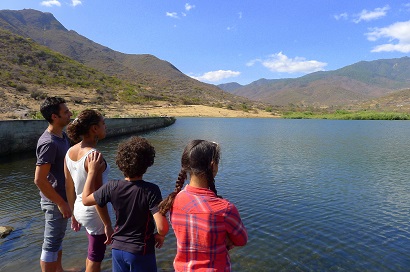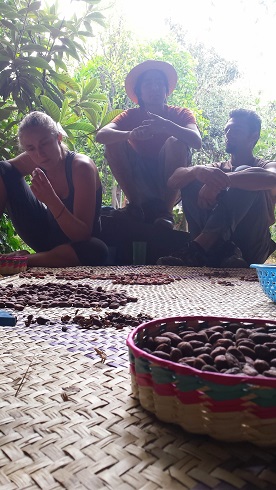 While some pueblos are almost emptied of their young people, gone to work the fields in the USA or to schools in the urban centers, others have youth like Aurelia and Eduardo. They carry cacao beans 3 hours on donkey and 10 more in camioneta from their family land to their autonomous chocolate producing cooperative (C.A.C.A.O.) in
While some pueblos are almost emptied of their young people, gone to work the fields in the USA or to schools in the urban centers, others have youth like Aurelia and Eduardo. They carry cacao beans 3 hours on donkey and 10 more in camioneta from their family land to their autonomous chocolate producing cooperative (C.A.C.A.O.) in 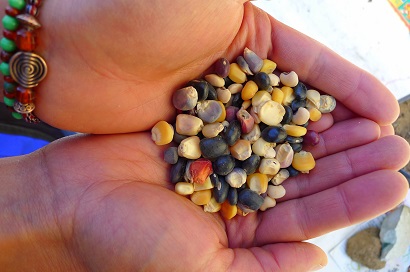 Huayapam. They learned the process from the grandparents and are working to bring the sacred, the story, and the justice back into the process of making chocolate.
Huayapam. They learned the process from the grandparents and are working to bring the sacred, the story, and the justice back into the process of making chocolate.
At CACAO, they explained to us the 2000+ year old spiritual and material history of this seed. It was a currency in Mayan society, but decomposed after a couple of seasons, and so could not be accumulated by the few, as is the case in a capitalist society. In effect, wealth expired after two years. Wealth had to be planted, returned to the earth, and cycled through the community. We learned also that cacao grows in the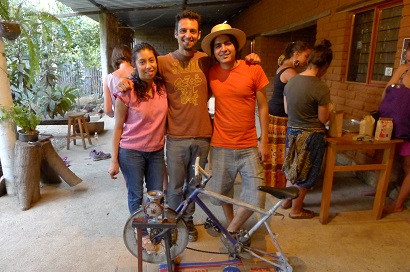 shade and represents death and internal energy. It’s brother is maize. Maize grows in the sun and represents life and external energy. When someone dies, friends bring chocolate and bread to the family and in the coffin, they place cacao, maize, and bule (water gourd).
shade and represents death and internal energy. It’s brother is maize. Maize grows in the sun and represents life and external energy. When someone dies, friends bring chocolate and bread to the family and in the coffin, they place cacao, maize, and bule (water gourd).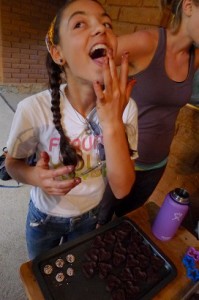
When Cortez arrived in Montezuma, he was given a gourd of chocolate to drink – the traditional bitter type sweetened with only a bit of honey and chili (called Xocalal). Along with women, gold, and riches, the Spaniards stole this cacao and its recipes and changed the meaning. No longer a sacred seed, they forced the people into slavery to produce chocolate for the nobles, who added a lot of milk and sugar and in doing so, colonized the 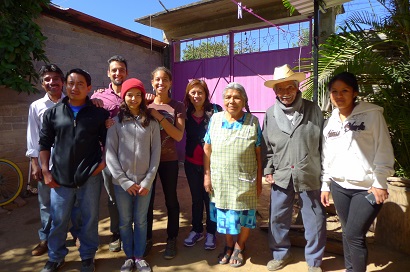 palates of the people. We had the blessed opportunity to learn to make cacao in the ancient way – hand washed, sun dried, roasted on a clay comal until it pops, hand ground and molded with a touch of honey and cinnamon. The taste
palates of the people. We had the blessed opportunity to learn to make cacao in the ancient way – hand washed, sun dried, roasted on a clay comal until it pops, hand ground and molded with a touch of honey and cinnamon. The taste 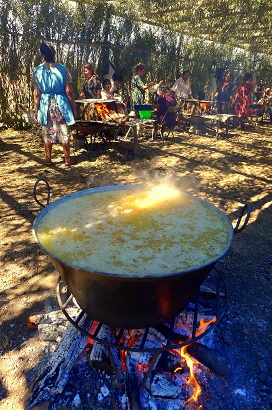 evades description.
evades description.
Siembra Konciencia is another powerful collective run by young people on the western edge of Oaxaca City. They catalyze urban gardens and collect waste for recycling using alternative currency as an incentive. We attended a seed, plant and knowledge exchange, where one of the organizers, Andrés gave us detailed instructions on how to plant a milpa (ancient intercrop of corn, beans, and squash). “Insert your digging stick and drop a single maize seed. Take one step, plant another. On the third 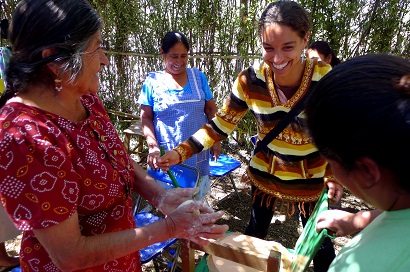 step plant maize with one bean seed. On the 6th step plant maize with squash seed. Plant on June 24, the sacred day of San Juan.” He also shared about the medicinal properties of many cultivars that also grow in NY – rue, lambsquarters, etc. We are thrilled to plant and care for the seeds we have gathered here and even purchased a hand grinder and tortilla press to be able to replicate the seed to tortilla cycle. As they say here in regard to
step plant maize with one bean seed. On the 6th step plant maize with squash seed. Plant on June 24, the sacred day of San Juan.” He also shared about the medicinal properties of many cultivars that also grow in NY – rue, lambsquarters, etc. We are thrilled to plant and care for the seeds we have gathered here and even purchased a hand grinder and tortilla press to be able to replicate the seed to tortilla cycle. As they say here in regard to 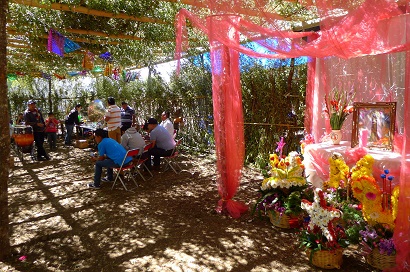 all of nature. “Yo te cuido, tu me cuidas” (I care for you and so, you care for me.)
all of nature. “Yo te cuido, tu me cuidas” (I care for you and so, you care for me.)
The original “collective,” of course, is the pueblo. We had a textured and powerful time as invited guests to the annual festival in Ayoquezco, about 90 minutes south of Oaxaca City. Friends three times removed invited us to sleep in their grandmother’s home and to share the intimacies of their community life. The town’s impressive 8 day festival entails feeding 4000 people on entirely donated labor and food – still preserving the gift economy of gozana and guelaguetza. The children who have migrated to the US for work all return to receive the generosity of the Mayordomo, who underwrites the material costs 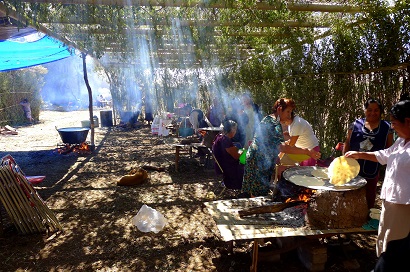 of the event (a great honor that most everyone aspires to attain). Leah made just 1 of the 7000 tortillas produced each day by 80 women working and chatting around hot comales. We learned from the 84 year old Doña of Tepache and Pulce the basics of fermenting these traditional drinks, made of cactus and wild pineapple, cured in buried earthen pots. We also attempted the traditional dance of the pueblo (each has their own), which has an Veracruz/African influence with quick intricate footwork. Not wanting to turn down anyone’s generosity, Leah and Jonah both drank more mezcal than was comfortable and Leah ate some large chunks of fresh beef (otherwise a vegetarian.) The family was interviewed on community radio about their impressions of
of the event (a great honor that most everyone aspires to attain). Leah made just 1 of the 7000 tortillas produced each day by 80 women working and chatting around hot comales. We learned from the 84 year old Doña of Tepache and Pulce the basics of fermenting these traditional drinks, made of cactus and wild pineapple, cured in buried earthen pots. We also attempted the traditional dance of the pueblo (each has their own), which has an Veracruz/African influence with quick intricate footwork. Not wanting to turn down anyone’s generosity, Leah and Jonah both drank more mezcal than was comfortable and Leah ate some large chunks of fresh beef (otherwise a vegetarian.) The family was interviewed on community radio about their impressions of 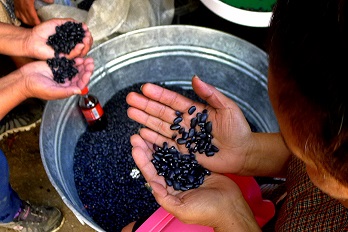 the town and the connections between campesino life in Ayoquezco and New York. For Emet and Neshima, the highlight was the impressive fireworks. Women danced through the night with large baskets on their head aflame with explosives that shot out loudly in all directions. Emet made good friends with the lady selling fireworks and received a generous bag for only 10 pesos and a few hugs. As guests of honor, we received a departing gift of two clay mugs full of pulce and tepache, an herbal sprig of rosa borracha, and 7 cigarettes wrapped in white
the town and the connections between campesino life in Ayoquezco and New York. For Emet and Neshima, the highlight was the impressive fireworks. Women danced through the night with large baskets on their head aflame with explosives that shot out loudly in all directions. Emet made good friends with the lady selling fireworks and received a generous bag for only 10 pesos and a few hugs. As guests of honor, we received a departing gift of two clay mugs full of pulce and tepache, an herbal sprig of rosa borracha, and 7 cigarettes wrapped in white 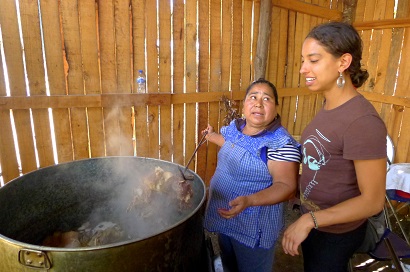 crochet in a painted calabash.
crochet in a painted calabash.
Leah has enjoyed getting her hands dirty regularly while teaching the university students how to grow food. She discovered a few sources of native seed and is experimenting with new greens and herbs and figuring out how to clearly and respectfully explain to her more novice co-teacher that mixing in 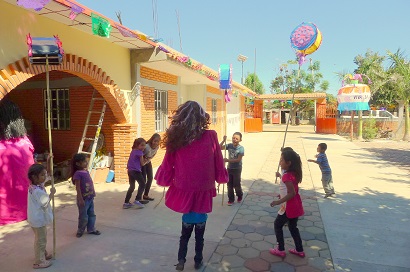 undecomposed mulch will rob nitrogen from the growing plants, et al. She is working hard to get the sustainable agriculture curriculum written in time and so far has finished chapters of intercropping, insect protein, yields of smallholders, and waste elimination. (She made herself eat chapulines – crickets – as a prerequisite to publishing the insect eating chapter.) Only 16 more sections to go, and then the translation! She is still making time to run, dance, or fly every day and just found a new running partner. Doña Juanita is an award winning marathon runner at age 71. She credits running with saving her life. 14 years ago she was nearly dead from severe marital violence and running gave her the strength and courage to get safe.
undecomposed mulch will rob nitrogen from the growing plants, et al. She is working hard to get the sustainable agriculture curriculum written in time and so far has finished chapters of intercropping, insect protein, yields of smallholders, and waste elimination. (She made herself eat chapulines – crickets – as a prerequisite to publishing the insect eating chapter.) Only 16 more sections to go, and then the translation! She is still making time to run, dance, or fly every day and just found a new running partner. Doña Juanita is an award winning marathon runner at age 71. She credits running with saving her life. 14 years ago she was nearly dead from severe marital violence and running gave her the strength and courage to get safe. 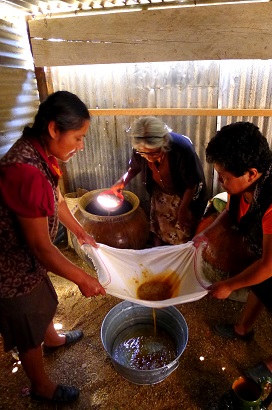 Her trainer taught her to stand up straight, eyes forward, and to GO.
Her trainer taught her to stand up straight, eyes forward, and to GO.
We have all enjoyed the closeness we are developing with our kindred Mexican family, Claudia, Samuel, and young Isham. Emet has had a couple of sleepovers at their home and impressed us with his ability to connect and feel joy even when no one around him speaks English. He is so happy to have someone with whom to wrestle, bike up mountains, and set up traps for the parents to fall into. 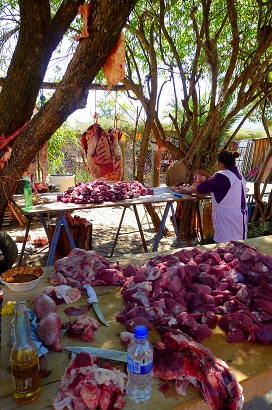 Isham had a crazy dream where he and Emet mixed up a secret potion that made Emet’s curly hair grow so big that it took 9 months for Isham to cut it and liberate the desperate Emet from the tangle. We had the joyous honor of holding a birthday celebration for Mama Claudia, enriched with ritual, song, jokes, and chocolate cake.
Isham had a crazy dream where he and Emet mixed up a secret potion that made Emet’s curly hair grow so big that it took 9 months for Isham to cut it and liberate the desperate Emet from the tangle. We had the joyous honor of holding a birthday celebration for Mama Claudia, enriched with ritual, song, jokes, and chocolate cake.
We are so grateful for Nonna Liz, Zaide Stewart, and Taina for making the long trip to be with us here in Oaxaca. Through their eyes we got to discover new things about our temporary home – the painted wooden carving (alebrijes), the 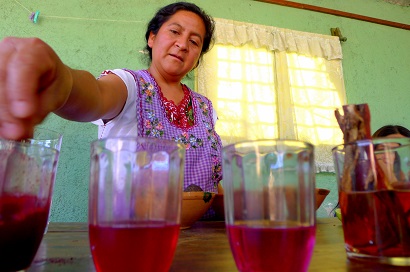 impressive nightlife of Oaxaca, and a beautiful lake and sacred mountain in Teotitlan. Taina fit right in and was evening performing at a restaurant on her third day here.
impressive nightlife of Oaxaca, and a beautiful lake and sacred mountain in Teotitlan. Taina fit right in and was evening performing at a restaurant on her third day here.
Somehow, we are still very busy with Soul Fire Farm work from afar. We are thrilled with the 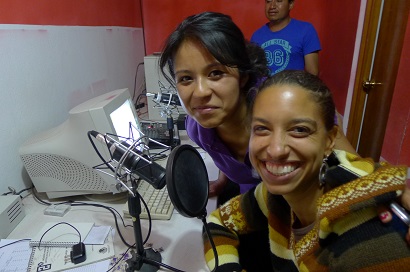 reception of Leah’s recently published YES! magazine article, Radical Farmers Use Fresh Food to Fight Racial Injustice and the New Jim Crow. Though we now are responding to a daily inbox full of requests for speaking engagements, interviews, conferences, and visits. We have been writing grant proposals, planning for the coming season, ordering cover crop seeds, talking with potential volunteers, and plugging away at the 501c3 application process. We also added some of our favorite recipes to the cookbook section of our website. Finally – we are excited to present, with a low bow to Gaetano Vaccaro, our Soul Fire Farm video. We are really proud of how it came out and excited to share with you.
reception of Leah’s recently published YES! magazine article, Radical Farmers Use Fresh Food to Fight Racial Injustice and the New Jim Crow. Though we now are responding to a daily inbox full of requests for speaking engagements, interviews, conferences, and visits. We have been writing grant proposals, planning for the coming season, ordering cover crop seeds, talking with potential volunteers, and plugging away at the 501c3 application process. We also added some of our favorite recipes to the cookbook section of our website. Finally – we are excited to present, with a low bow to Gaetano Vaccaro, our Soul Fire Farm video. We are really proud of how it came out and excited to share with you.
Check out more of our photos from the past few weeks here.

